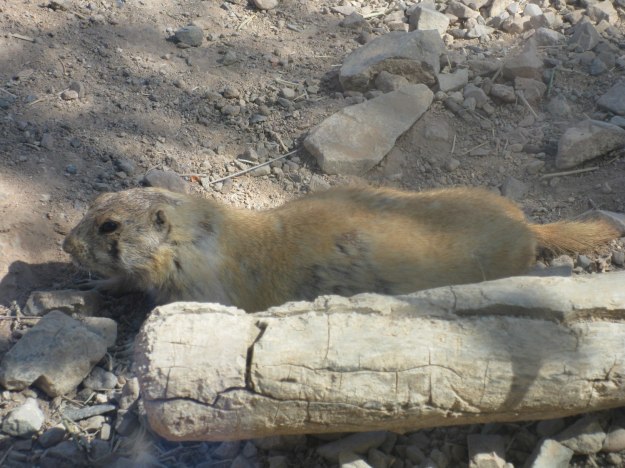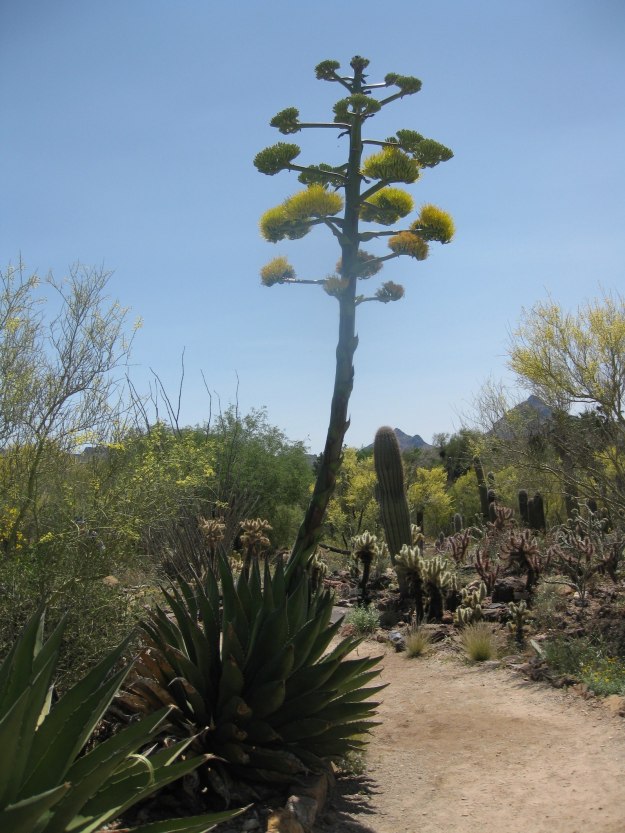On April 21st we arrived in Catalina State Park, near Tucson. The day was quite simple, we set up camp, relaxed and made supper. The fun began the next day. After breakfast, we headed to the Arizona Sonoran Desert Museum. Opened in 1951, it is the first regionally focused museum. The layout of the Ecomuseum in Sainte-Anne-de-Bellevue, Quebec is very similar to this layout. In fact, the Ecomuseum was modeled on the Sonoran Desert Museum. We were able to meet Stephane Poulenc, a McGill alumnus, the Curator of the museum as well as the Director of the herpetology department. It’s nice to see the possibilities and locations we, students, can attain after graduation (though we both agree that we prefer colder temperatures).
One of the strengths of the Sonoran Desert Museum is its outreach and educational program. There is appropriate and attractive infrastructure to support their multiple educational programs. The volunteers and employees were very passionate and knowledgeable about the animals and plants present. They have approximately 600 volunteers and it seems like a very popular location for local people and tourists. We were able to watch a presentation on venomous reptiles; the Gila monster and an Arizona black rattlesnake. There is a much bigger presence of venomous organisms in the southern United States than in Canada!
The museum is divided into the different ecosystems present in the Sonoran desert; mountain woodland, desert grasslands, desert, riparian habitat, life on the rocks, and an aquarium. Additional areas were dedicated to minerals, hummingbirds, cave habitats, and the history of the region, both physically and culturally. This museum is not only focused on the fauna of the area but has multiple gardens that exhibit the local flora, especially cacti.
Most of the animals in the enclosures come from rehabilitation centers since they can no longer be reintroduced into the wild. Unfortunately, due to the black market demand for exotic animals, law enforcement seizures also supply the museum fauna. There are only a few common species that they acquire from the wild.
The area of the museum itself is quite large, making it easy to feel incorporated into the desert ecosystem. It is easy to stop and relax because of the added shaded areas and many water fountains. Moreover, every restroom has sunscreen dispensers! Very smart of them to add, since we Canadians have been dealing minimal sunlight for the past few months and our skin is extremely sensitive.
Highlights of our visit
The prairie dogs
These are smaller versions of the groundhogs we have back home. Very cute and still chubby. Interestingly, they would scratch the ground and then flatten themselves, like a pancake, to, we assumed, help cool themselves. Their pups seemed more interested in food than cooling off. But don’t let their cuteness fool you, they participate in infanticide, the killing of their young. Sadly, this practice occurs in many species. Sometimes nature is scary (actually most of the time, just look up tarantula wasps).
Cactus and Agave Garden
Past the prairie dogs, there is a cactus garden. It was very interesting to see the diversity of these plants. We always assumed it was mostly the Saguaro cactus in this area. Hollywood has deceived us. The biodiversity was quite high despite the harsh and dry conditions. Obviously these various species are rarely found together, but it encompasses the variety within the Sonoran desert. Some had no spines, some were purple or gold, some seemed very, very prickly. Moreover, the agave plants were very impressive. Large bottom leaves, a tall single stalk and yellow bunches of flowers. The bottom leaves, despite the seeming lack of defense indeed had spikes, on the edges, to protect themselves from predators. Going through these gardens has opened my mind to the wonders and variety of fauna in the desert. Just because the environment seems barren, it does not mean animals and plants can’t make it their home.
Insects and Lizards
One thing we both noticed was the quality of the insect and reptile viewing facility. Furthermore, the insect stations were interactive, lifting up “rocks”, lighting UV lights (scorpions glow in UV light, how cool!). The lizard enclosures allowed for proper viewing and there were many, many more species than the few we have in Quebec. Winter is worse for the reptiles than lack of water. It was nice to see that they did not neglect the little critters, since they are essential for the proper functioning of an ecosystem, even if they aren’t the most charismatic creatures out there.
Even though we, ideally, would have wanted to see all of this biodiversity in the wild, we are aware that it is impossible, and I guess this is the purpose of these types of museum. It helps make people aware of the nature surrounding them. And maybe helps them make a connection with it and be more willing to conserve it.



